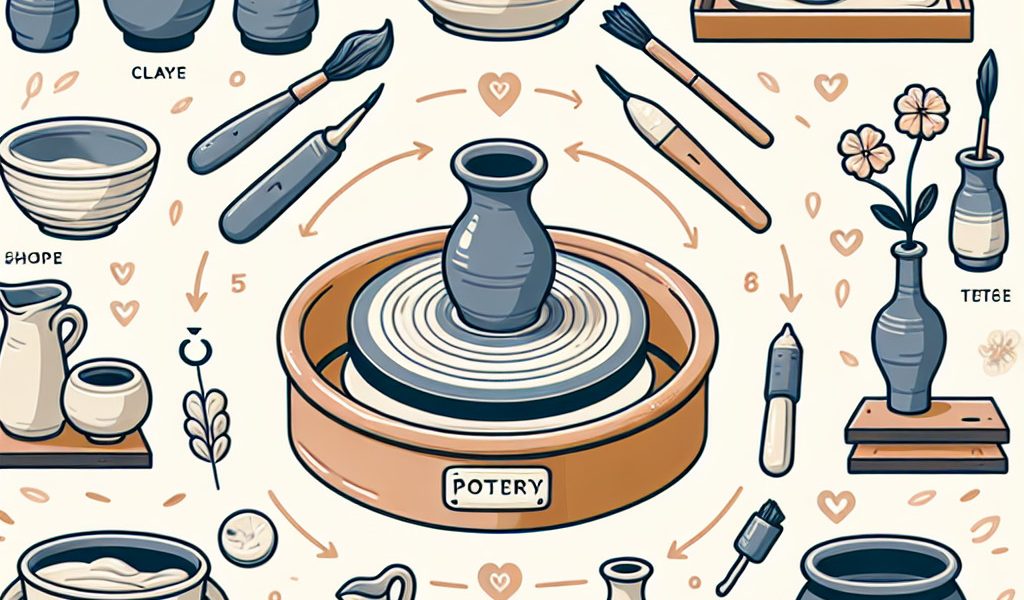Crafting with Clay: A Novice’s Journey into the Art of Pottery Making
Introduction to pottery
Pottery is an ancient art that involves creating objects from clay, then firing them to harden them and make them usable. Whether you want to make utilitarian or decorative pieces, the practice of pottery offers a multitude of creative options. In this guide, we will give you the basics to get started in this exciting universe.
Plan the object to create
Before embarking on creating a ceramic piece, it is important to determine a few key elements:
- Size : what size do you want your object to be? Take into account the space you have to work and store your creations.
- Shape : what shapes do you want to give to your object? You can draw a sketch to better visualize the final result.
- Function : Is it a utilitarian object (like a bowl or cup) or purely decorative (like a sculpture)? This will influence the choice of material and techniques used.
Choosing the right material: types of clay and firing temperatures
When we talk about “pottery,” we usually think of objects made from clay. However, there are different types of clays, each with their own characteristics and firing temperatures:
- Stoneware clay: also called “stoneware”, this clay is very resistant once fired. It is particularly suitable for utility objects (dishes, pots) and is fired between 1200 and 1300°C.
- Porcelain clay: this clay is renowned for its fineness and translucence after cooking. It is ideal for decorative pieces or fine objects such as refined tableware. The cooking temperature varies between 1200 and 1400°C.
- Earthenware: more porous than stoneware or porcelain, earthenware has a matte appearance after cooking. It is suitable for decorative objects but can also be used for utility pieces if it is enameled. The cooking temperature is generally around 1000°C.
Manufacturing methods: potter’s wheel, hand modeling, coil mounting or pattern printing
To make your ceramic creations, several techniques are available to you:
potter’s wheel
This is probably the image that first comes to mind when we think of pottery: the wheel allows you to quickly and precisely shape symmetrical objects (like bowls, cups or vases). However, this technique requires a certain investment in equipment and practice to master the gesture.
Hand modeling
Hand modeling is a more accessible method that does not require specific equipment. Simply knead the clay with your fingers to give it shape. This technique is particularly suitable for decorative or sculptural objects.
Cove assembly
This method consists of assembling “sausages” of clay to create an object. It allows you to create a variety of shapes and offers great creative freedom. The coil assembly is suitable for both utility objects and decorative pieces.
Pattern printing
To add relief or patterns to your creations, you can use different printing techniques: stamps, textured rollers, natural prints (leaves, shells)… Let your imagination run wild!
Take pottery training
To learn the basics of pottery and progress quickly, it can be useful to take training from a professional:
- Group lessons : they are offered by art schools, cultural associations or private workshops. They allow progressive learning in a friendly environment.
- Intensive courses: If you want to learn quickly, pottery courses are a good solution. They generally take place over several days and allow you to acquire specific skills (potter’s wheel, enamelling, etc.).
- Online course : for those who prefer to learn at their own pace, there are platforms offering video courses or written tutorials.
Getting started without specialized equipment
No need for a complete workshop to start pottery! Here are some tips for making your first creations without investing in expensive equipment:
- Opt for hand modeling or coil mounting: these techniques do not require a potter’s wheel.
- Collect everyday objects to work with clay: knife, spoon, rolling pin…
- Bake your pieces in a domestic oven: some clays (like earthenware) can be fired at low temperatures. Be sure to check the manufacturer’s instructions before baking your creation!
Note: Cooking in a domestic oven can present risks and does not always guarantee optimal results. It is recommended to call on a professional to fire your pieces when you have better mastery of the techniques and want to obtain a quality result.
By following these tips and practicing regularly, you will soon become a pottery expert! Don’t hesitate to share your creations with other enthusiasts to exchange tips and progress together in this fascinating art.
